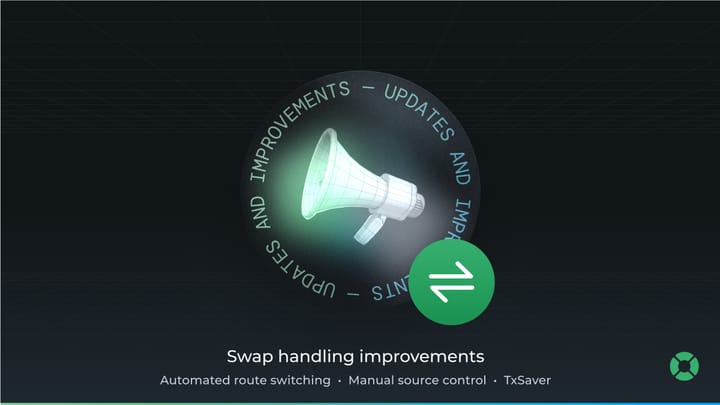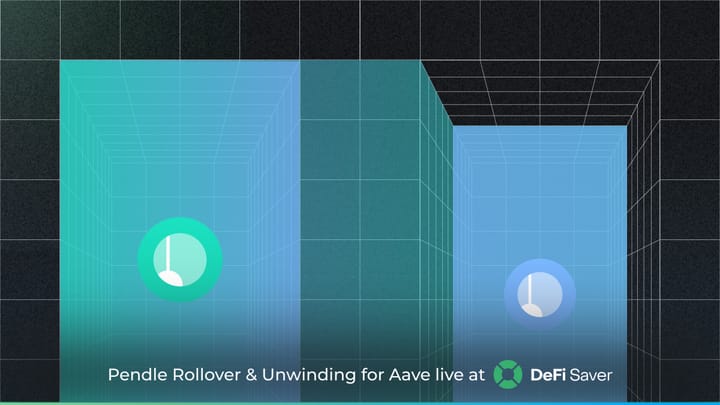LUSD Chicken Bonds now available at DeFi Saver
What are Chicken Bonds? How do they work? Where does the yield come from? Check out the potential strategies which you can use in DeFi Saver.
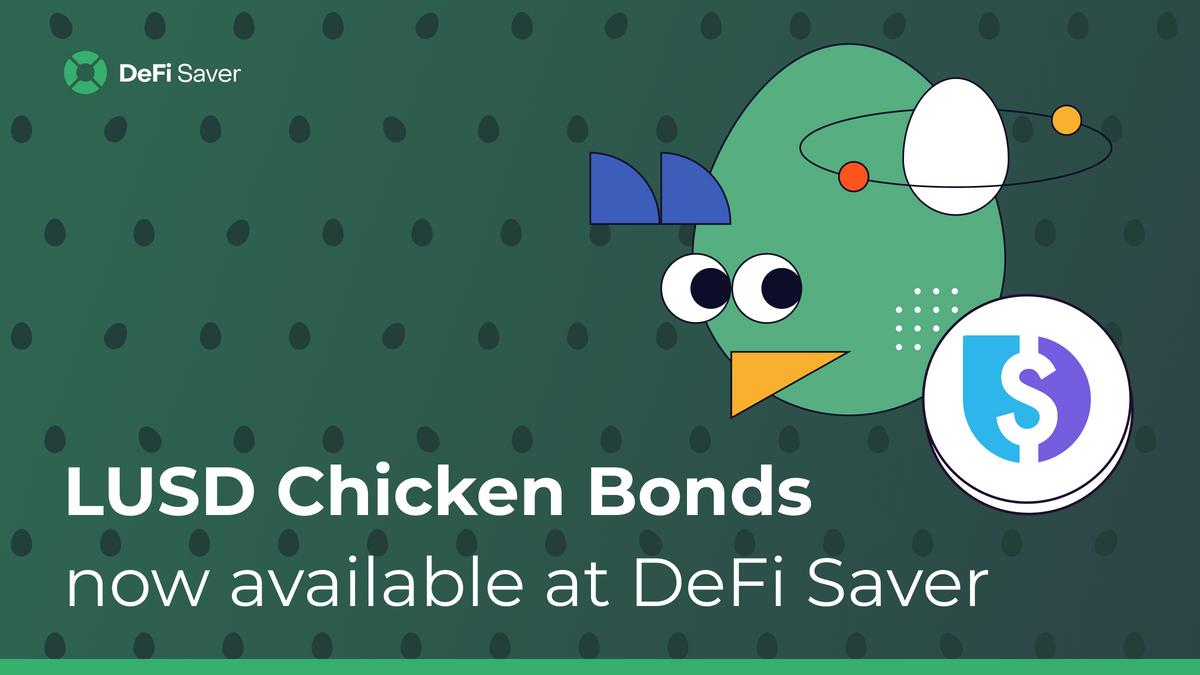
Following a wave of "DeFi 2.0" protocols whose aim was to attract POL (Protocol-Owned-Liquidity) by introducing various mechanisms including bonding, we now have a new, sustainable bonding solution developed by the team that brought us the Liquity protocol: Chicken Bonds.
What are Chicken Bonds?
TL;DR: Chicken Bonds are a novel bonding protocol that allows users to earn amplified yield (from multiple yield sources) on their principal which is protected (users can withdraw 100% of their initial investment by cancelling the bond any time, but forgoing the accrued yield) throughout the bonding process (no maturity date, bonds are perpetual and can be claimed any time).
This new gamified bonding mechanism will be first applied to the Liquity stablecoin itself - LUSD, though the team plans to rollout a generalized CB solution in Q2 2023 for other protocols and DAOs to bootstrap their liquidity at minimal cost.
The Chicken Bonds protocol went live on Mainnet on October 4, 2022 and starting today, Chicken Bonds are available at DeFi Saver, too!
How does the bonding mechanism work?
We'll try to give a short breakdown of the Chicken Bonds mechanisms below in as simple terms as possible.

The flow looks like this:
- The first step is to get some LUSD by either buying it on the open market or by opening a Liquity Trove.
- The second step is to bond LUSD and get the bonding NFT which accrues virtual balance of bLUSD (boosted LUSD) over time according to a plateauing curve (see picture below).
- The next step is to claim bond (aka Chicken-in) to obtain the accrued bLUSD in exchange for deposited LUSD, when the value of accrued bLUSD equals LUSD invested (this moment is referred to as the "Break-even point") or later.
- Alternatively, users can cancel the bond (aka Chicken-out, hence the name - Chicken Bonds) withdrawing 100% of their principal back and forgoing the right to claim accrued bLUSD. Reasons could be many, e.g. if the user needs LUSD to pay back debt, or finds better yields elsewhere, or other.
- Once users Chicken-in, they may further compound their yield profits by selling the bLUSD for LUSD on the open market (Curve bLUSD/LUSD3CRV pool) and rebonding with a larger amount of LUSD principal, or hold the bLUSD they claimed if they think that would result in higher yield. The deciding factor here would be the premium at which the bLUSD trades.
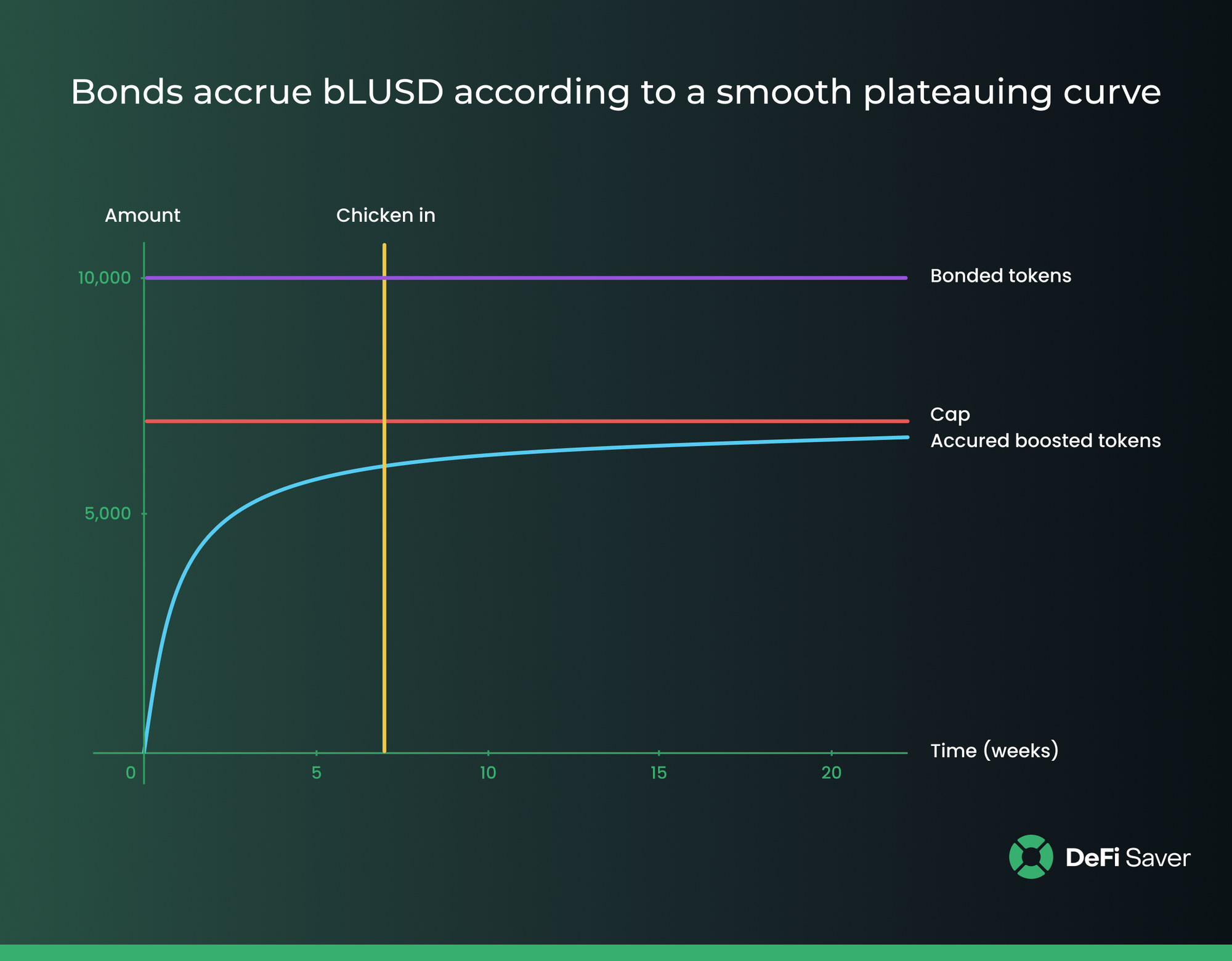
Strategy of simply holding bLUSD after Chickening-in may be more attractive (e.g. if the market price of bLUSD is relatively close to the redemption price of bLUSD) up to some point. Once the premium at which bLUSD trades gets high enough, it would be optimal to sell it for more LUSD on the market (Curve bLUSD/LUSD3CRV pool) and then rebond with a larger LUSD principal (long-term wise). This moment is referred to as the "Optimum rebond time".

It's also worth noting that users can simply buy bLUSD on the open market, thus avoiding the bonding period, but acquiring bLUSD at the market price instead of the redemption price.
Furthermore, users can also buy (or sell) their whole position in the form of NFT on an NFT marketplace (e.g. on LooksRare).
Behind the scenes
The Chicken Bonds protocol operates a treasury consisting of 3 different buckets, which all contain LUSD and earn yield:
- Pending Bucket: holds the LUSD from all open bonds (which have not yet been Chickened-in or out of).
- Reserve Bucket (POL): receives a portion of the bonded tokens from the Pending Bucket upon Chicken-ins and captures the yield from all 3 buckets.
The Reserve bucket backs the whole bLUSD supply, meaning that bLUSD is fully redeemable for the LUSD in the Reserve. This results in a guaranteed bLUSD price floor, which can only increase and never decrease. - Permanent Bucket (POL): holds excess (other portion of) LUSD diverted from bonds that were Chickened-in “early”. The LUSD in here is protocol-owned and can never be redeemed.
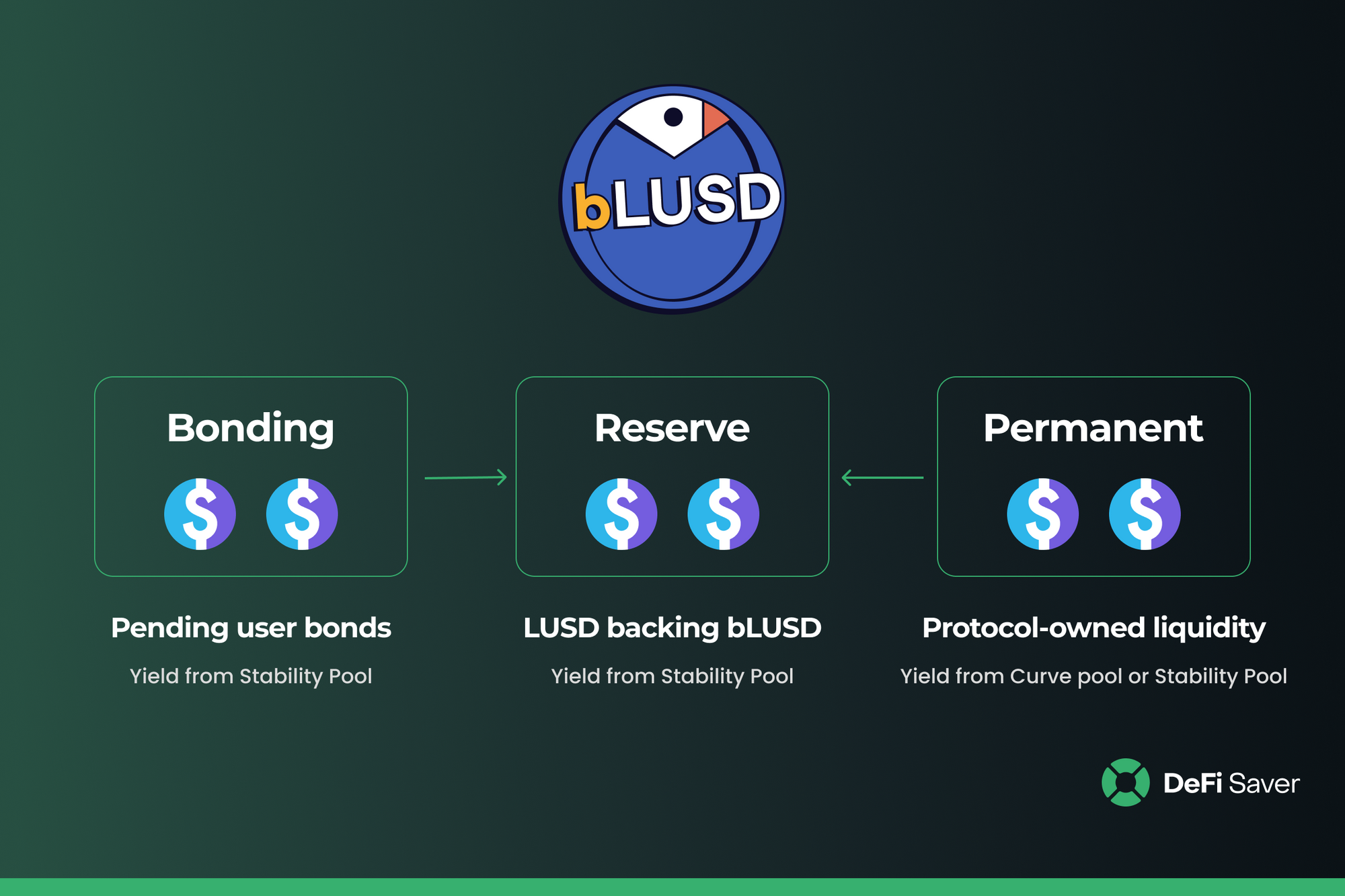
These buckets are virtual constructs inside the Chicken Bonds system (not pools themselves) and are purely used for internal accounting.
Where does the yield come from?
The LUSD funds held by the system are allocated to two yield sources:
- Liquity Stability Pool - the Chicken Bonds protocol uses B.Protocol for Stability Pool deposits, which is pooling liquidity for reinvesting LUSD into SP by selling ETH from liquidations & LQTY rewards back to LUSD.
- Yearn Curve LUSD vault - where Yearn deposits LUSD to Curve LUSD-3CRV pool and stakes LUSD-3CRV LP tokens via Convex to get both CRV & CVX alongside trading fees from the LUSD-3CRV pool.
The yields from these sources are harvested and auto-compounded (done by both B.Protocol & Yearn). Crucially, all of the LUSD yields flow to the Reserve.
bLUSD is proportionally redeemable for LUSD in the Reserve: that is, if you hold x% of bLUSD supply, you can redeem it for x% of the Reserve (ignoring fees) at any time.
Yield Amplification Mechanics
Yield amplification in Chicken Bonds stems from the fact that yields from all three protocol buckets (Pending, Reserve, Permanent) flow to the Reserve bucket. Therefore, the LUSD quantity in the Reserve grows faster than the “natural rate” at which LUSD (from the Reserve Bucket) compounds.
This results in the rising price floor (redemption price) of bLUSD in the Reserve bucket, which is essentially representing the amplified yield for bLUSD holders.
Reserve also gets the yield accumulated by the users who decide to Chicken-out and thus forgo their yield.
Potential strategies for Chicken Bonds
- Bonding Strategy - (open Trove), create a bond by depositing LUSD, chicken-in and claim bLUSD after the break-even time, sell bLUSD for more LUSD and rebond (or hold bLUSD a bit longer and then rebond).
- Trader Strategy - if the price of bLUSD is close to the redemption price -> buy bLUSD (with a low premium), vice versa.
- Liquidity Provision Strategy - (open Trove), create a bond by depositing LUSD, chicken-in (claim bLUSD) after (or before) the break-even time, provide liquidity in the bLUSD pool on Curve to earn trading fees.
- NFT strategy - factors that increase the chances of getting a rarer NFT are having an open Trove, voting for LUSD+3CRV gauge on Curve Finance, and staking LQTY.
- Buy Low and Hold Strategy - simply buying bLUSD on a DEX and holding it for amplified yield, with limited downside risk (guaranteed price floor through redemptions).
- Arbitrage Bot Strategy - every time the market price goes below the redemption price, the bot will buy bLUSD and redeem it for LUSD.
- Combination of all (or some) of the strategies explained above (users can have multiple bonds on one account).
For more details about Chicken Bonds protocol, please check the official docs.
LUSD Chicken Bonds in DeFi Saver
Before we go over both basic and advanced DFS features we've prepared for LUSD Chicken Bonds, we should mention that our integration is focused around the dsproxy (aka smart wallet), as all of our other integrations, too, meaning that any new bonds you create using DeFi Saver will be created on your smart wallet.
Additionally, the migrate functionality will also be available from day one, allowing all existing bonds/positions on EOAs to switch to the Smart Wallet for any potentially advanced features (e.g. doing claim bLUSD + sell bLUSD + rebond in just one transaction).
First off, looking at our UI, you can now find a new dedicated "Bonds" tab for LUSD Chicken Bonds on the Liquity dashboard, right next to the Notify tab (ICYMI, we've recently released Notification features too).
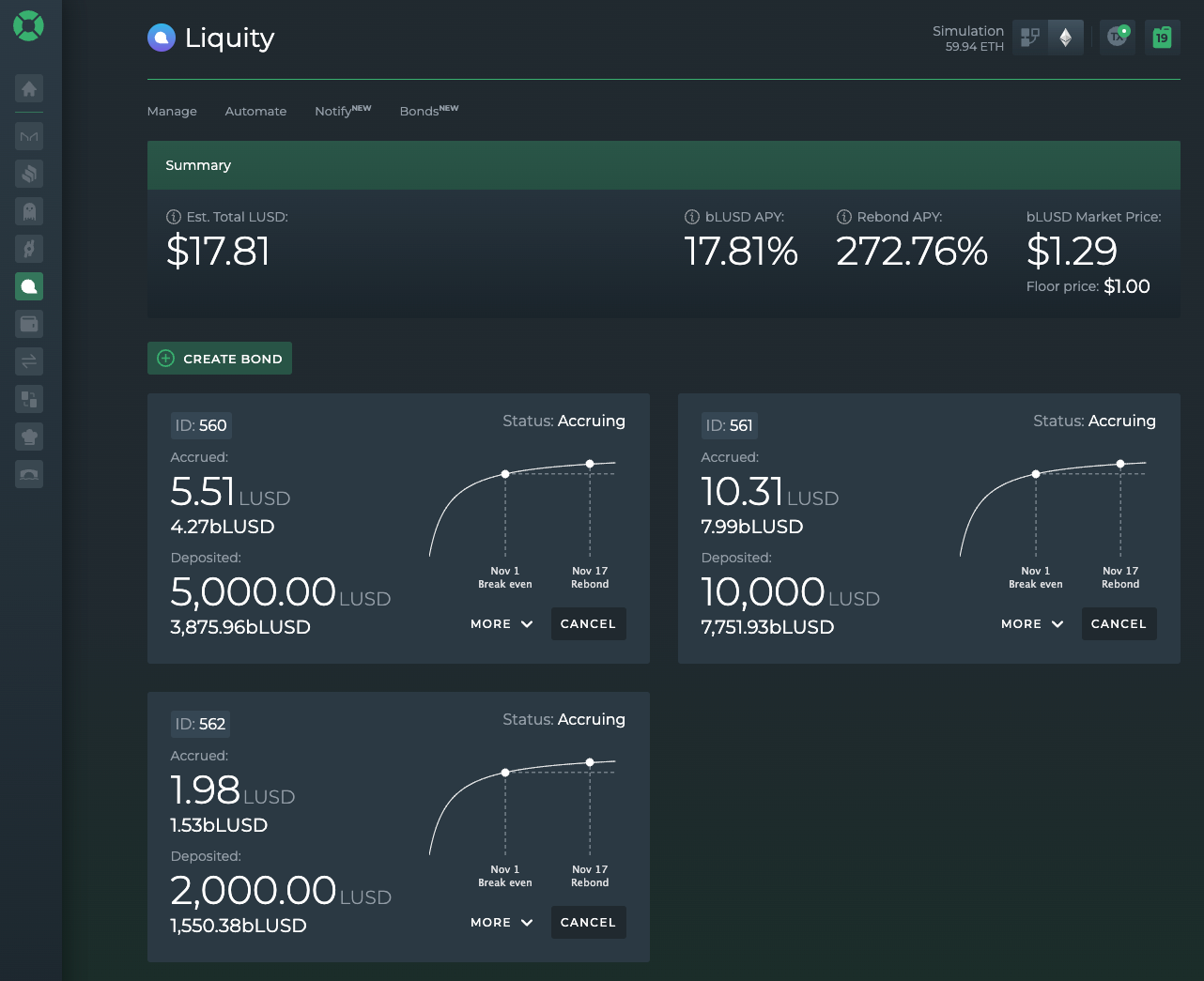
Users are able to create multiple bonds per account, while their dynamic NFTs representing those individual bonds can be viewed by hovering over their IDs. Important to note that these NFT positions can be transferred to any address at any point in time, transferring at the same time the LUSD principal and the right to claim accrued bLUSD.
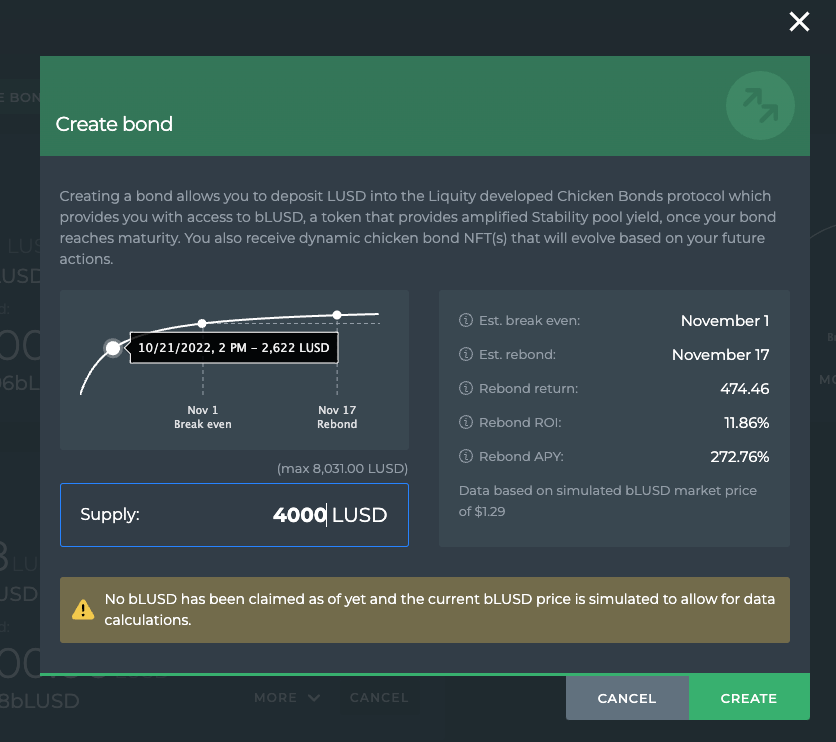
As always, we are encouraging our users to first check out and try all available options (create, cancel, claim, transfer) in the app using the Simulation Mode, prior to actually depositing any capital.
We've also prepared a neat graph for each bond showing a breakdown of the bLUSD accrual rate, including both Break-even and Rebond (estimated) dates.

Important Note: First chicken-ins (claims of bLUSD) are expected to happen on October 19th 2022 (15 days from the LUSD Chicken Bonds protocol release), meaning there will be no market (price) for bLUSD before that. Therefore, only Create and Cancel options will be available before this date. Claiming, selling, and rebonding will be available afterwards.
Advanced actions for LUSD Chicken Bonds in DeFi Saver
Based on the nature and design of the Chicken Bonds system, combining certain protocol actions seemed logical, especially in terms of applying the optimal bonding strategies. Therefore, our new CB dashboard introduces a couple of advanced, unique features:
- Claim + Sell is an action that would claim accrued bLUSD and automatically sell it for LUSD on the open market.
- Rebond, on the other hand, would claim accrued bLUSD, sell it for more LUSD, and create another bond with the now larger amount of LUSD principal.
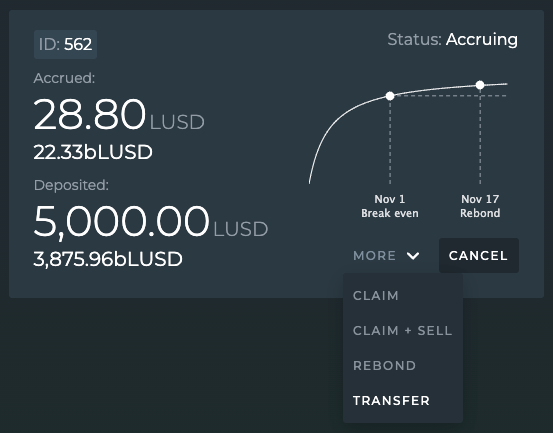
As would be expected from DeFi Saver, we also plan to work on Automation options for these actions where users could configure different custom triggers. For example, users would be able to specify the thresholds for automated bLUSD claiming or for automated execution of the rebonding strategy.
On top of that, we could also share a glimpse of some automated strategies we want to introduce later on that would combine Liquity with LUSD Chicken Bonds, so here's one of the combos we want to enable:
- Open a Trove, deposit LUSD into Chicken Bonds, configure liquidation protection CR threshold which would result in withdrawing the LUSD principal and paying back (part of) Trove's debt if triggered AND configure another trigger for auto-claiming bLUSD (+sell & rebond as optional steps).
As always, we'd love to hear any other ideas for automated strategies and really any feedback for our new Chicken Bonds integration, so make sure to join us in the DFS discord!

